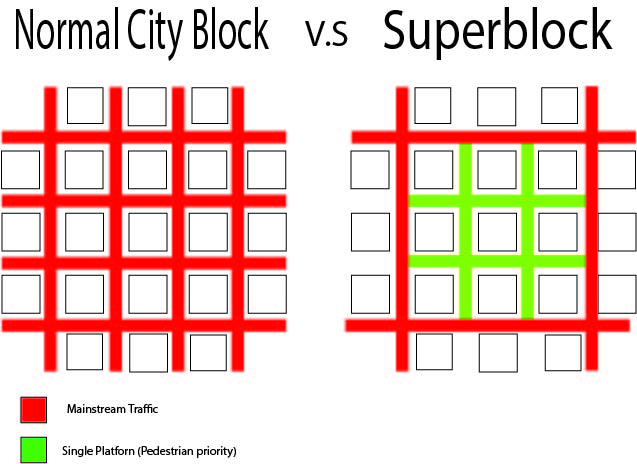October 14, 2021
City Superblocks, the future of urban planning
If you go to most American cities, you will see large metal beasts called cars that push humans aside into small corners to walk in. The noise of honking and revving of engines floods our ears and pollutes the air. This is the sad reality of our cities’ images. Highways cut through the downtowns of our cities; pedestrians are forced to wait at crosswalks until a light blue man symbol prompts them to cross. What if there was another way? What if pedestrians could walk free without worrying about cars or waiting at crosswalks or relying on automobiles as a main form of transportation? Say hello to the city superblock.
To know about city superblocks, we must first analyze how our cities are built. If you look at a satellite image over any big city, you will notice one commonality: huge roads spread out across the city, cutting right through it. However, this was not always the case. Many Americans used to walk across the streets and took street cars to get around the city. After the widespread use of the automobile, a $425 billion investment over half a century created the Interstate Highway System. While these large roads connect the country they also cut right through the downtown of our cities. These highways were amazing for rural communities as they got more traffic and business and had an easier method to transport goods. The 48,000 miles of road have no doubt brought wonders to the rural communities and to America as a whole, but their role in individual cities is not as magnificent. In the building of these highways, entire neighborhoods were often destroyed to make way for the roads. Wealthier families moved to the suburbs where they commuted to the city by car, while poorer, often black communities took the toll and saw their entire neighborhoods bulldozed to the ground. An example of this is Njeri Camara who was interviewed in a CNN article and said that her childhood home is inaccessible because it was bulldozes to the ground. Her current house is also at risk of being bulldozed for yet another highway.
You have probably heard it a million times but yes, the Climate Crisis is coming. More than a quarter of the USA’s CO2 emissions come from transportation. Of that quarter, 60 percent of them are emitted from cars. Most Americans in the city and metropolitan area rely on cars as a main form of transportation and that is exactly the opposite of what we need. We need to have people find alternate means of transportation and plant more trees to suck in carbon. For this, city superblocks may be a reasonable solution.
City superblocks can vary in size and cost, but they share the same concept. They are a much bigger “super” city block, hence the name city superblock. According to The European Association of Cities in Energy Transition, They are usually around 400 by 400 meters and according to cleantechnica, in Barcelona the cost of the project was about 10 million euros. Superblocks work by taking a grid-shaped area of a big city and limiting the number of cars, if any, that can go through there. Sidewalks are expanded, bike lanes are added, trees are planted, benches, as well as public parks are installed, and curbside parking is replaced with underground parking. City superblocks are meant to make cities greener and less reliant on cars. City superblocks are proven to lower Co2 emissions and make city air cleaner. A perfect example of this is Barcelona, a city that has brought city superblocks into the spotlight. Barcelona had a big air and noise pollution problem. The failure to meet air quality standards led to 3,500 premature deaths due to air pollution. They implemented superblocks with the goal of, according to Citiesforums, “Reducing private vehicles journeys from 26.04% to 18.48% and to have 81.54% of all journeys on foot, bicycle, and public transport journeys by 2024.” The city wanted to make their air cleaner and city less noisy and the data was clear. Particle pollution went down 38%, the city managed to lower urban noise by 5.5 decibels. Aside from lower emissions, economic activity went up as pedestrians went out more and shopped instead of occasionally driving to get what they needed. City superblocks worked for Barcelona, but can they work for American cities?
A large factor in establishing city superblocks in a city is public opinion and support for investing in them. Here are some responses I got from students in IHS. Many students believe cities are built around cars. Many say that city layouts are built around a central structure or area like a downtown of a city. Junior Sebastian Mabie says, “That’s usually where the money is, the farther you go out the more money there is.”
Freshman Lia Hanson says, “That’s less than I expected but still a lot, you only spend a couple of minutes in traffic each day but all of that adds up to a lot longer than you think. The proposed solutions to traffic were split between getting rid of reliance on cars and redesigning our traffic laws as well as coming up with more efficient ways of traffic control.
According to a WHO (World Health Organization) estimate, 1 in 8 people in this world die due to air pollution or air pollution influenced deaths. Almost all the students said that there were way too many deaths and air pollution was a problem that needed to be fixed. Most proposed getting rid of the main emitters and switching to renewables as well as consuming less meat.
Junior Priya Bedi says, “First of all, not back out of agreements and having everyone do their part. Public transportation, everyone is idling on the road but if people were on trains or buses the number of cars on the road would decrease. Also, the meat industry contributes a lot to global warming so if more people were conscious, it would make a difference.”
Students were split between the importance of highways in urban vs rural communities. Some said that rural communities were more spread out and thus relied more on highways while others said that cities had more people that needed to get around and that highways were more important in urban cities. “I think it is important to have Highways near urban cities, if you look at I-5 it connects major cities. It’s kind of needed everywhere to connect the country.” says sophomore Luka Lawrence.
Most students are unfamiliar with superblocks but said that they would be effective at helping reduce pollution although cost was a large issue. All the students preferred to walk or bike around a city rather than drive.
There are some perceived issues with city superblocks. Many say that limiting off cars in parts of the city could cause traffic issues as it would clot roads. City superblocks also need to be spread out to circulate drivers. Some said that the money could be spent on other “more important” things. “Well, that’s millions that could be spent elsewhere on other things.” Says freshman Christian Olsen. “I guess if it makes people happy and there’s less driving then it’s worthwhile,” he adds.
Most of the students think city superblocks are a good option and a good solution to pollution problems in our cities. However, not all were on board with the idea as they questioned its importance.
City superblocks present a viable solution to a large issue that threatens all of us in the future. The question is if they will be implemented in American cities. Are they truly the future of cities? Will there be a better solution or design in the future? All can be said, but with a little push, American cities could see a dramatic change.





